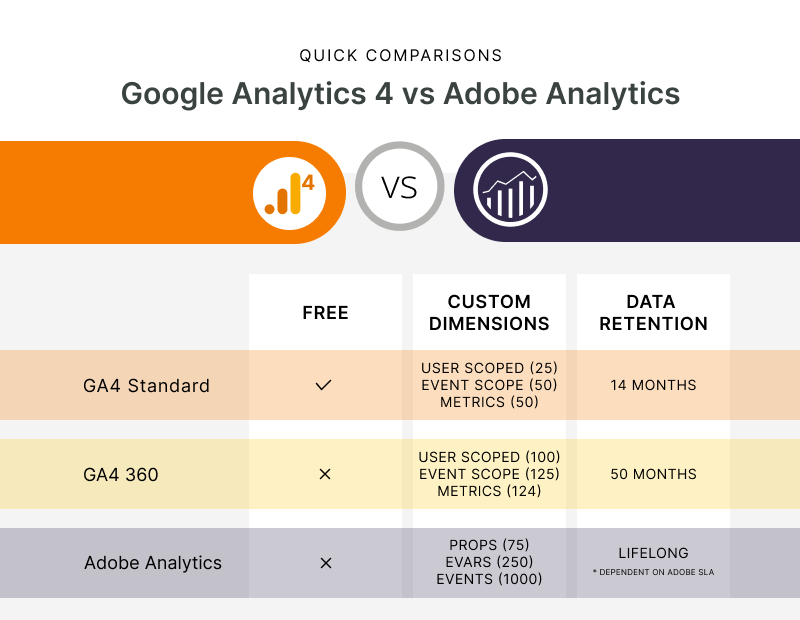This website uses cookies. By continuing to browse the site, you are agreeing to our use of cookies
What is the better choice: Google Analytics 4 or Adobe Analytics?
Data & Analytics
May 6, 2024
*This post originally appeared on Softcrylic.com. Softcrylic is a Hexaware company.*
Overview
Today we are going to talk about the newest web analytics platform by Google, Google Analytics 4 (GA4), and its comparison, similarities, and improvements compared to another main offering in the analytics space, Adobe Analytics.
It is important to note that GA4, like UA (Universal Analytics), has both a free version and a paid version called Analytics 360 enterprise solution. For this comparison we will cover features between Analytics 360 (GA4) and Adobe Analytics (paid version) to allow a better comparison and wider view of the features available from each analytics offering.
GA4 Overview
Google Analytics 4 is the latest version of Google Analytics, introduced in 2020 and will eventually be the only analytics offered by Google replacing Universal Analytics in 2023. GA4 introduces app and web analytics all in one place. The new platform has machine learning built into itself to help you better understand your customers at every point of their journey. This along with many other new features are some of the top highlights within GA4.
How does GA4 work?
Google Analytics 4 tracks user interactions across websites and apps in data streams, so you can sit together in a single bucket of data all while having the ability to slice and dice as you see fit. For example, you can create reports showing conversions across videos, paid ads, organic searches, and email campaigns. By doing this, Google helps build an understanding of your combined marketing efforts and make better decisions in the future.
GA4 uses event-based tracking, but the old Google Universal Analytics used website tags. This improvement allows you to monitor user interactions or events in real-time. Before continuing It is worth noting that real time reporting in Google Analytics is advertised as both a Standard and GA360 offering but the processing time is much longer in Standard than in 360 and I would say that the real time reporting is a 360 offering only. The beauty of this new feature is that you can monitor searches while they happen instead of looking back at site searches.
Google Analytics 4 has increased the integrations with other tools in the Google family. Many improvements have been made to, for example, the Google Ads integration. You can deliver content that is more relevant at the right time to your audiences. Web and app analytics are now working together, and you can easily understand your marketing efforts.
GA4 is by design focused on privacy, so tightening privacy regulations or changes with cookies should be future proof. Instead, it uses a flexible approach to measure and fill out any gaps if data is incomplete.
Adobe Analytics Overview
Like Google Analytics, Adobe Analytics is designed to collect, process, and analyze the data to help you make data driven decisions and provide the information you need to create powerful user experiences. Adobe Analytics is the only analytics offered by Adobe and is a part of the Adobe Experience Cloud Suite, allowing you to analyze data from the entire customer journey and understand web behavioral data.
How does Adobe Analytics work?
The web analytics report in Adobe Analytics allows you to build an understanding of who comes to your site and why, the traffic sources, the pages, and products shown or visited—all in real-time. Since it is a part of the Experience Cloud you have a great ability to combine analytics data with other 3rd party data sources, giving you a total view of your customer.
Marketing analytics reports go past just web analytics, but in the center lies the customer journey and its various online and offline channels. The view of the customer journey helps you paint a picture of your customer, detect anomalies, and conduct cohort analysis.
The marketing analytics report gives you a great insight into the actions, but the attribution reports create insight into what works and does not. Adobe’s attribution analytics uses machine learning to better understand each touchpoint. Understanding what works allows you to see the value of each piece of content.
Adobe also allows you to build predictive reports to see what might happen in the future. The feature uses machine learning and advanced statistical modeling to picture outcomes. Predictive reports are especially useful when predicting customer behavior.
What’s Different?
We have talked about each platform individually, so let us look deeper into what separates them from each other.
We cannot make a comparison without first talking about the investment and pricing. Google Analytics 4 does offer a free Standard experience to use until your company’s website requires more custom event parameters or custom user properties. When you exceed the quota for GA4, you need to move to Google Analytics 360 that does have a price. On the other hand, Adobe Analytics has a large price tag from the start, and large companies are the platform’s target audience. So, entering the world of analytics, Google has a much easier to conquer barrier in kicking off data collection.
Setup
Google has already created many home pages and pre-made reports. You can easily jump right into your data and start investigating. So, setting up does not require that much knowledge of the platform itself. Adobe Analytics, however, has a slightly more complex set up and report creation.
The platform does not offer ready-made views, requiring you to build reports themselves. It would help if you were more data-oriented and more data mature to use Adobe Analytics.
Reporting
GA has some excellent pre-configured reports that are ready to use right out of the box for tracking website performance, acquisition patterns, engagement, and so on. You do not have to create any report or add metrics/dimensions to view general website performance. However, GA reports are not interactive, meaning that if you share reports, they will not have the liberty to analyze in depth. It is advised to use Data Studio (Google’s reporting and visualization tool) if you would like entire website performance and user activity statistics in an easier to consume format.
Adobe offers its own set of tools for advanced reporting and visualization within AA itself, which allows you to build a customized report. Building segments and creating calculated metrics can be done in the blink of an eye. This illustrates the fact that AA is more of a complete analytics tool while GA is more of a reporting tool.
Custom dimensions and metrics
The way custom data is sent to GA is through custom dimensions and metrics. These custom dimensions have a scope of hit, product, session, or user, while the custom metrics have values like time, currency, and numbers. GA offers both user and event scoped custom dimensions along with custom metrics. With GA4 Standard you have a max of 25 user scoped, 50 event scoped and 50 custom metrics. When you upgrade to GA4 360 you increase to 100 user scoped, 125 event scoped and 125 custom metrics. Additionally, the possibility of using BigQuery for cloud computing adds customization possibilities for quick and efficient analysis.
The hit level dimension in GA is comparable to the “Traffic Variable” (props) that AA offers. AA’s “Conversion Variable” (eVars) can have a scope of either hit, product, session, or user. AA offers 250 eVars, 75 props, and 1000 events. The customization choices are endless thanks to the ability to use eVars, Props, and success events for data capture. AA also offers a system comparable to GA with Adobe Data Warehouse, although it is slightly more limited than BigQuery.
Data Retention
While GA4 only stores customer data up to 14 months and GA360 up to 50 months, AA provides lifelong customer data storage. Additionally, AA can store cookies for approximately 15 years, whereas GA can only keep them for a month. This implies that organizations can concentrate on their clients for longer periods of time by using AA.
Which to Choose?
In a Nutshell: The right tool for the right company at the right time
Choosing the ideal analytics tracking platform is not an easy task. It heavily depends on your business goals, the level of insights you are seeking, your budget, the other tools you use, and your analytics’ team.
If you ask my opinion, GA4 is best for small businesses and startups searching to conduct a free and accurate analysis of their website on their own. However, AA is a better choice for firms that are prepared to invest in advanced e-commerce and technical analytics. When comparing AA to GA4 360 I do think the gap is closed more when you compare both paid versions of the tools.
Quick Guide

About the Author

Brian Williams
Brian is a proven Digital Analytics Consultant with end-to-end digital analytics experience from requirements gathering, to implementation, testing and reporting. In additional to Digital Analytics strategy and implementation, Brian is also experienced with other Mar-Tech tools such as Google Analytics, Domo and Tableau. Brian holds the Adobe Analytics Business Practitioner Expert Certification and the Adobe Real-Time CDP Sales Certification. In additional, Brian also holds the Google Analytics and Google Tag Manager certifications. Brian has a passion for data collection and using that data to help make data driven decisions. As an analytics consultant, Brian strives to provide clients with accurate and robust analytics tracking.
Read more
Related Blogs

Enterprise Data Services: The Backbone of Modern Businesses
- Data & Analytics

Navigating Databricks’ Delta Lake Features and Type Widening
- Data & Analytics

Top 13 Data Science Services Providers: Bridging the Gap Between Data Capabilities and AI Strategy
- Data & Analytics

The Role of AI in Automating SAS to PySpark Conversion and Accelerating Data Migration
- Data & Analytics

How to Achieve New Standards in Data Quality and Observability using Databricks Lakehouse Monitoring
- Data & Analytics

Retrieval-Augmented Generation (RAG) on Amazon Bedrock
- Data & Analytics

Databricks Unity Catalog for Comprehensive Data Governance
- Data & Analytics

Ready to Pursue Opportunity?
Every outcome starts with a conversation










